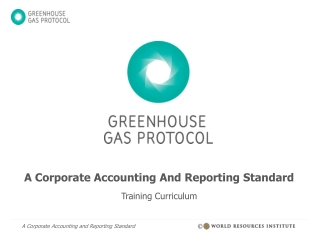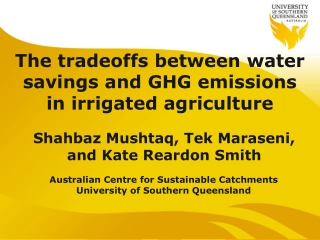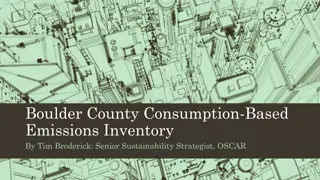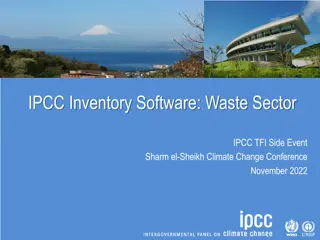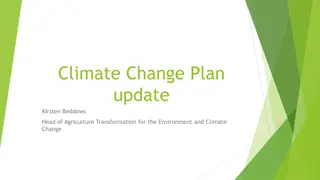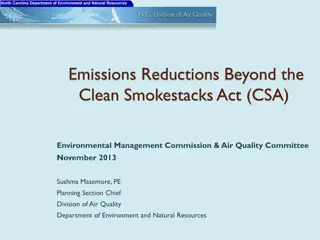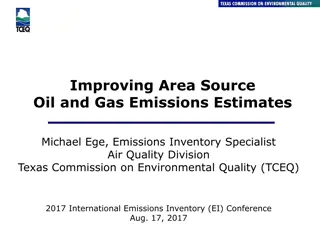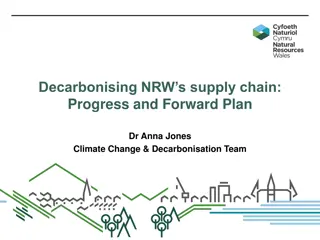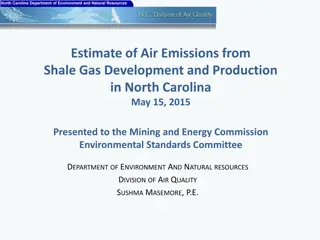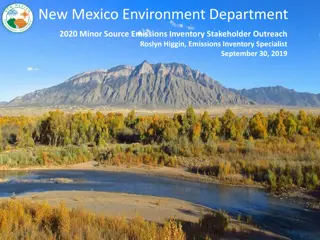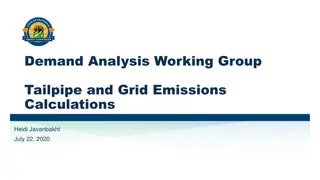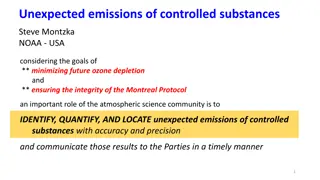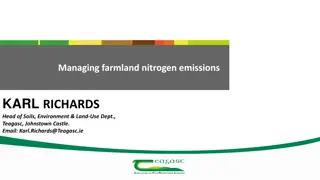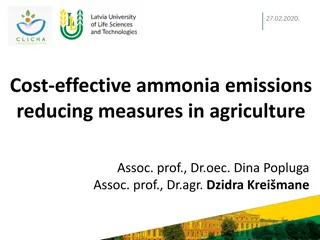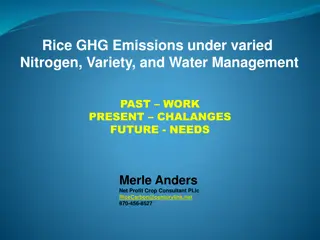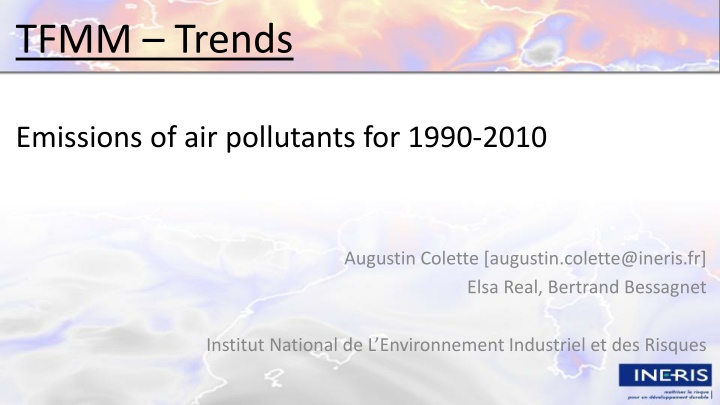
Air Pollutant Emissions Trends 1990-2010 Overview
Explore the emissions of air pollutants from 1990 to 2010, sources of information, regional datasets, and quantitative comparisons over Europe. Get insights into key pollutants like NOx, NMVOC, SOx, NH3, PM, BC, and OC for modeling and assessment purposes.
Uploaded on | 0 Views
Download Presentation

Please find below an Image/Link to download the presentation.
The content on the website is provided AS IS for your information and personal use only. It may not be sold, licensed, or shared on other websites without obtaining consent from the author. If you encounter any issues during the download, it is possible that the publisher has removed the file from their server.
You are allowed to download the files provided on this website for personal or commercial use, subject to the condition that they are used lawfully. All files are the property of their respective owners.
The content on the website is provided AS IS for your information and personal use only. It may not be sold, licensed, or shared on other websites without obtaining consent from the author.
E N D
Presentation Transcript
TFMM Trends Emissions of air pollutants for 1990-2010 Augustin Colette [augustin.colette@ineris.fr] Elsa Real, Bertrand Bessagnet Institut National de L Environnement Industriel et des Risques
Emissions of air pollutants for 1990-2010 Overview of available sources of information Will ultimately be used for the modelling Criteria for selection Completeness 1990-2010 Available by activity sector, spatially gridded Key pollutants: NOx, NMVOC, SOx, NH3, PM or BC&OC
Emissions of air pollutants for 1990-2010 Regional datasets preferred to global inventories (EMEP or GAINS preferred to EDGAR, ACCMIP ) EMEP emissions used in modelling lacks PM before 1999 GAINS has been revised in 2014 for 1990-2010 (ECLIPSE-V5) Provided by Zig Klimont & Chris Heyes => ECLIPSE-V5 is a good candidate Need to benchmark wrt other sources to assess uncertainties Also an issue since other sources are used in global models (used for Boun. Cond.)
Emission details EDGAR / ACCMIP / MACCCity Primarily designed for chemistry-climate MACCCity: monthly, ACCMIP before 2000, RCP85 after EMEP: as used in models ECLIPSE-V5 GAINS national totals (updated after TSAP2013) provided for all RCP sectors (energy, industry, solvent use, transport, agriculture, open burning of agricultural waste, residential combustion, and waste treatment) Spatially at 0.5 resolution based on RCP-consistent proxies.
1965-2008 EDGAR v4.2
Available species NMVOC (as a sum) YES SO2 NOx NH3 CO CH4 PM2.5 PM10 BC OC OM ECLIPSE V5 MACCity GEA - RCP 85 CLE EDGARV4.2 EMEP YES YES YES YES NO YES YES YES YES YES YES YES YES NO YES YES NO NO YES YES NO YES YES YES YES YES YES NO NO YES YES NO YES YES YES YES YES YES NO NO NO NO NO YES YES YES YES YES NO YES YES NO NO NO
Quantitative Comparisons over Europe Domain used for comparison : Longitude: min= -15; max= +35 Latidude: min=37.5; max=65
PM25 EMEP/ECLIPSE quite different for recent years
PM25: by sector 1200 1000 800 ECLIPSE-V5 2010 600 EMEP 2010 400 GEA 2010 200 0 Energy industry EMEP/ECLIPSE difference moslty due to Residential, Industry, Agriculture Residential combustion Industry Solvants Land transport Other transports Waste Agriculture
PM25: trends by sector Residential combustion Land transport 1800 1800 1600 ECLIPSE 1600 Annual PM25 emissions in kT Annual PM25 emissions (kT) 1400 1400 EMEP 1200 1200 ECLIPSE 1000 1000 GEA EMEP 800 800 GEA 600 600 ECLIPSE -non road transport 400 400 200 200 GEA - non road transport 0 0 1990 1995 2000 2005 2010 1990 1995 2000 2005 2010 Industry 1800 1600 Annual PM25 emissions (kT) Despite differences in totals, trends by sector are broadly similar 1400 1200 ECLIPSE 1000 EMEP 800 GEA 600 400 200 0 1990 1995 2000 2005 2010
NOx GAINS Granier CC, 2011 ECLIPSE still higher than other sources but not as much as in Granier et al. 2011
NOx: transport Transport (SNAP 7 and 8) NOx (kT, NO2) - 2010 12000 6000 ECLIPSE-V5 2010 10000 5000 EMEP 2010 Annual NOx emission (kT NO2) ECLIPSE - Land transport EMEP - Land transport GEA 2010 4000 8000 GEA - Land transport MACCity 2010 3000 MACCity - Land transport 6000 ECLIPSE - Other transports 2000 4000 EMEP - other transports GEA - Other transports 1000 2000 MACCity - Other transport 0 0 Energy industry Industry Land transport Waste 1990 1995 2000 2005 2010 The overestimation in ECLIPSE is due to land transport, the difference is constant over 20yrs
NOx: Energy Energy (SNAP 1) 12000 10000 Annual NOx emission (kT NO2) 8000 ECLIPSE EMEP 6000 GEA 4000 MACCity 2000 0 1990 1995 2000 2005 2010 Decreasing trend: ECLIPSE > EMEP > MACCCity
SO2 All the sources are quite consistent (except EDGAR)
SO2: by sector SO2 - 2010 5000 4500 4000 SO2 emissions par sector (kT) 3500 3000 ECLIPSE-V5 2010 2500 EMEP 2010 2000 GEA 2010 MACCity 2010 1500 1000 500 0 Energy industry Residential combustion Industry Solvants Land transport Other transports Waste Agriculture Slight discrepancies at sectoral level: Might have an impact on spatialisation
NMVOC Large uncertainties, especially for EDGAR The discrepancy EMEP/ECLIPSE in the 1990s is a concern
NMVOC: by sector NMVOC (KT) - 2010 4500 4000 NMVOC emissions per sector (kT) 3500 3000 2500 ECLIPSE-V5 2010 2000 EMEP 2010 GEA 2010 1500 1000 500 0 Energy industry Residential combustion Industry Solvants Land transport Other transports Waste Agriculture Discrepancy EMEP/ECLIPSE due to other transports
NH3 ECLIPSE & EMEP quite consistent MACCCity & GEA: less focus on NH3
Conclusions & Questions for Discussion On the paper, ECLIPSE-V5 is a good source for AQ hindcast over Europe Benchmarking with other sources show: PM: not much comparison possible NOx slighlty high compared to other sources, but constant in time SO2 very consistent VOC: large spread NH3: good consistency EMEP/ECLIPSE
Open issues Are there gaps at national level that do not appear on these Europe-wide comparisons? Esp. for PM: not reported before 1999 How to deal with NO/NO2 changes ? To be discussed by Bertrand tomorrow: Using Country-totals ? Spatial distribution: ECLIPSE or in-house ? Temporal profiles ?
PM25 gap filling in EEA dataviewer 2000 1800 1600 1400 1200 PM2.5 as reported in the EU emission inventory (EEA) 1000 800 PM2.5 from EMEP (for model used) 600 400 200 0 1990 1991 1992 1993 1994 1995 1996 1997 1998 1999 2000 2001 2002 2003 2004 2005 2006 2007 2008 2009 2010 2011 2012 Linear extrapolation was performed if one or several years at the beginning or at the end of a time series were missing, and if at least 5 consecutive years showing a clear trend (r2 0.6) were available. Extrapolation 'backwards' was never allowed to result in negative values. extract from the EEA Technical report No 12/2014 ( European Union emission inventory report 1990 2012 under the UNECE Convention on Long-range Transboundary Air Pollution (LRTAP)

